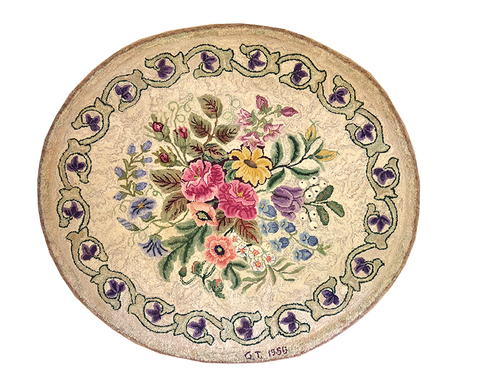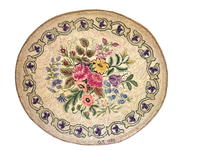Rug Hooking: A Common Thread
From generation to generation, the thread continues

Multiflora, 46" x 41", hand-cut, hand-dyed wool on burlap. Designed by Pearl McGown, hooked by Gladys Turberg, Thomaston, Connecticut, 1956.
It’s a “parts day” in the workshop. Darry Nicholson measures out pieces of maple he’s milled himself, puts the pencil between his teeth, places the metal tape measure aside on the workbench, and lowers the blade on the table saw to make the cuts. He flips on the dust collector and, as it fills like a hot air balloon, he walks to the planer. The motor whirrs to life and, as the wood passes through it sings, filling the air with the fragrance of freshly cut wood and promise. As he passes the pieces through the plane—another and another, all by hand—it’s like a dance, a soft-shoe in the sawdust, the next step intuitively following the last. As he cuts and sands, his brother-in-law Bill is stationed at the bench drilling screw holes and gluing the sides of the octagons for the frames. When the machines are running, it’s noisy and there is little talk. When the machines are silent, sometimes Bill makes a joke to lighten the mood, other times the only sound is the thunking of wood like kid’s blocks and the puff of the glue bottle.
Like his father before him, Darry has been a carpenter all his life. A few years ago, wanting to slow down a little, get off roof jobs and stick closer to home, Darry built a workshop on the back of his barn-style garage and set it up with the large machinery he acquired over the years—all manner of saws, compressors, drill presses, sanders, lathes, even a portable sawmill and a kiln for milling and drying his own wood. When he built the workshop, he really had no idea what his projects would be.
Looking back now, maybe it did not come as a huge surprise to Darry when he started building and selling rug hooking frames at this late stage in his career. Not only did his wife, Jan, hook rugs, but Darry himself had been around rugs and their artists all his life. His grandmother Gladys introduced her daughters Bev and Phyllis (Darry’s mother) to the craft.
Read NextSharon Smith



